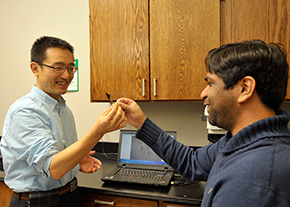Research Highlight: Gong Gu

The study of the properties of boundaries between different materials—something that could one day change the world of electronics—is getting a boost from research being done by Gong Gu, an associate professor in the Min H. Kao Department of Electrical Engineering and Computer Science. Gu, working with fellow scientists at Oak Ridge National Laboratory, initiated a research effort to seamlessly join two two-dimensional crystals, earning a spot in the journal Science earlier this year.
“When you grow typical three-dimensional crystals on top of one another, the interface where they meet is, by default, two-dimensional,” said Gu. “That process is called heteroepitaxy. We’ve taken that a step further by joining a pair of two-dimensional crystals, which makes that boundary where they meet one-dimensional.”
The two materials, hexagonal boron nitride and graphene, have structures that line up nearly perfectly with one another—like an atomic zipper, in a sense. Just as importantly, the electrons along the boundary are predicted to be “spin polarized,” meaning they prefer to all spin in the same direction. This property is vital for applications in the emerging field of spintronics, which seeks to manipulate and use the spin of electrons to carry and process information, which may impact the future of all aspects of electronics.
The use of scanning tunneling microscopy provided the first look at electrons along the one-dimensional boundary.
“This work is just a stepping stone,” Gu said. “While the eventual outcome holds promise, the copper foil that the two crystals grow on destroys the spin polarization. The next big thing is to observe the spin polarization by stripping the copper away without harming the boundary.”
These images at left, taken from a high-powered microscope at Oak Ridge National Laboratory, offer a first look at electrons along a one-dimensional boundary between graphene and hexagonal boron nitride.